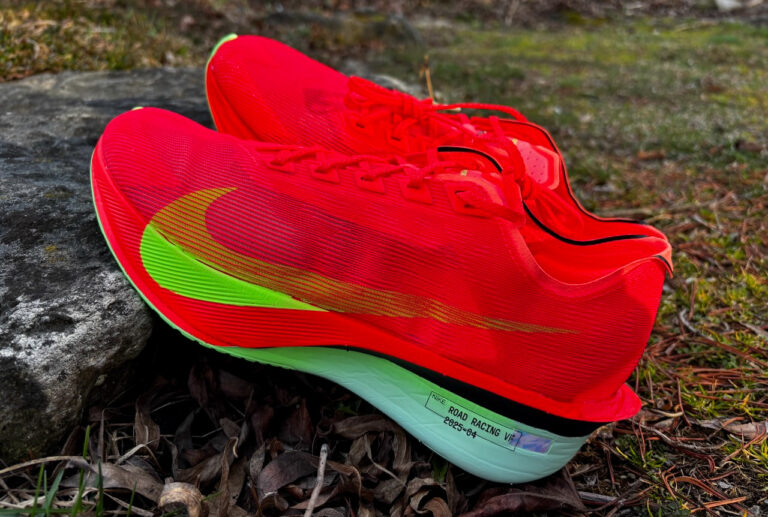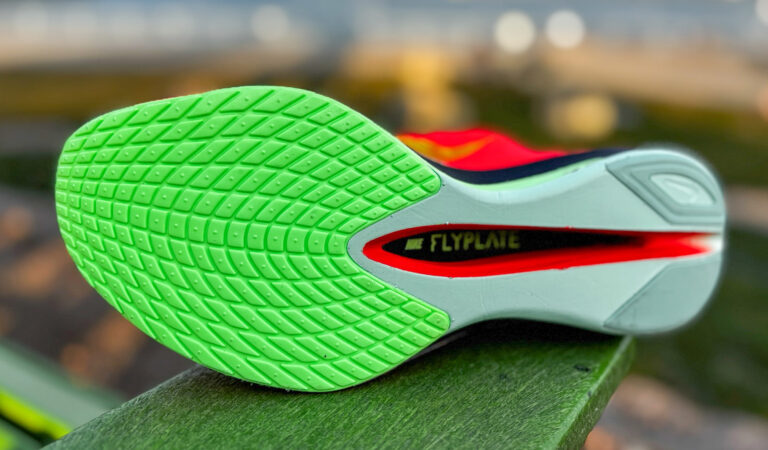Since its explosive debut in 2017, the Nike Vaporfly series has rewritten the rules of racing shoes, blending space-age tech with boundary-pushing performance. A trailblazer in the carbon-plated running shoe revolution, the Vaporfly line ignited an era where lightweight plates and superfoams became the key for speed. Loved by elites chasing records and everyday runners hunting PRs, the line has become synonymous with speed. The Nike Vaporfly 4 arrives not as a revolution, but as a meticulous refinement—a shoe that polishes its predecessor’s strengths while addressing subtle flaws. Is it still the king of the racing circuit? Let’s dive in.
Table of Contents
ToggleKey specifications:
Brand: Nike
Model: Vaporfly 4
Weight: 9.8 oz. (277 g) for US 9 model
Heel: 35 mm
Toe: 29 mm
Heel drop: 6 mm
Carbon plate: Yes
What’s new in Nike Vaporfly 4?
The Vaporfly 4 isn’t a head-turner at first glance, but beneath its familiar silhouette lies a series of calculated tweaks. Nike trimmed the heel collar for a sleeker fit, reworked the midsole’s geometry for smoother transitions, and introduced a grippier outsole pattern. The upper, now using Atomknit 3.0, feels like a “second skin” compared to the Vaporfly 3’s slightly bulkier wrap. It’s the kind of upgrade that whispers rather than shouts—until you start running.
Price of Nike Vaporfly 4
Price: $260 USD
Release date: April 2025
Upper

The new Atomknit 3.0 upper is a marvel of engineering—stretchy yet structured, breathable yet secure. Unlike the Vaporfly 3’s occasionally rigid forefoot, this version wraps toes like a breathable mesh glove, with laser-perforations boosting airflow. Runners noted fewer hotspots, even during marathon-length efforts.
Nike finally nailed the tongue. Gone is the slippery, minimalist flap of old; the Vaporfly 4’s semi-gusseted tongue stays centered, with just enough padding to prevent lace bite. The flat, ribbon-like laces lock down midfoot tension without digging.
The heel collar is lower and softer, ditching the Vaporfly 3’s sometimes abrasive rigidity. Internal padding is minimal but strategic, cradling the Achilles without bulk. One tester praised it for eliminating blisters during downhill sprints—a notorious weak spot in earlier models.
Midsole

The soul of the Vaporfly remains its full-length ZoomX foam and carbon fiber plate. This duo still delivers that addictive “trampoline” effect, propelling you forward with each toe-off. But the midsole’s sculpting is smarter now: a slightly rockered geometry smoothes transitions from heel to toe, reducing the “slappy” feel some criticized in the V3.
It’s softer underfoot than the Vaporfly 3, but not squishy—think “cloud with a purpose.” The foam compresses just enough to cushion, then snaps back fiercely. Marathoners will appreciate the balance of comfort and responsiveness, especially past mile 20.
The thin, removable insole is unchanged—functional but forgettable. Some testers swapped it for orthotics, though Nike purists argue it’s best left untouched to preserve the shoe’s intended feel.
Outsole

Nike swapped the V3’s geometric tread for arrowhead-shaped rubber pods, concentrating coverage under high-wear zones. The result? Better grip on wet roads and sharper corners. While the outsole still isn’t as durable as a daily trainer’s (this is a race shoe, after all), the stickier rubber compound resists wear better than previous versions. Confident on asphalt and track surfaces, though a few testers noted slight slippage on painted crosswalks in rain. For dry conditions, it’s flawless.
Who Should Buy It (And Who Shouldn’t)?
Buy If:
- You’re chasing PRs in races 5K to marathon.
- You’re a neutral runner with efficient form.
- You crave that “boosted” sensation without sacrificing cushion.
Avoid If:
- You need stability features (this shoe is firmly for neutral gaits).
- You want a daily trainer—save these for race day.
- Your budget is tight. At $260, these are an investment.
Verdict
The Nike Vaporfly 4 doesn’t reinvent the wheel—it just lets it roll faster. By refining the upper, tweaking the midsole, and sharpening the outsole, Nike has crafted a racing shoe that feels more complete than its predecessor. It’s not perfect (the price stings, and wet traction could improve), but for runners seeking every possible edge, it’s still the shoe to beat. For those wanting a budget-friendly hybrid for training and racing, the Nike Zoomfly 6 offers versatility without the premium price tag.
Final Word: If you loved the Vaporfly 3, the upgrades here are worth the splurge. If you’re new to supershoes, start here—it’s the pinnacle of speed, refined.


